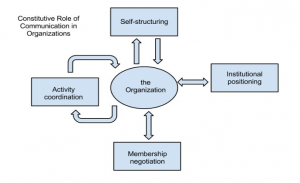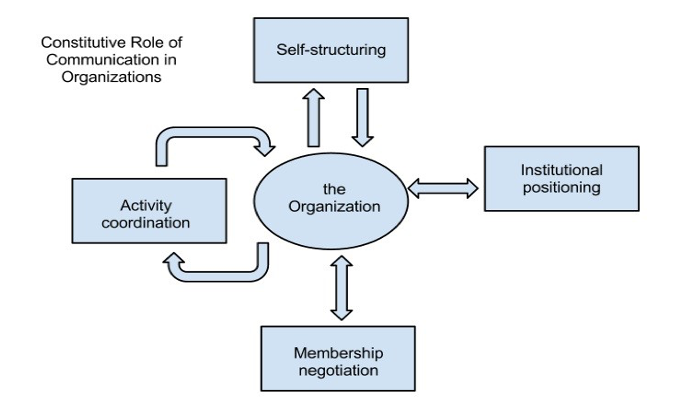by Dr. Emily Ball Cicchini, Executive Director
As we kick off this new year, our 49th of continuous operation, the challenge of communication across the many members of BookSpring remains. BookSpring is both grassroots and established, local and digital, and volunteer and professional. How do we manage all the different ways that people engage with our organization to gather and share information and decision making?

I’m reminded about a theory called the Communicative Constitution of Organizations. Through this perspective, organizations are managed best through 4 flows of communication: Activity coordination, Membership negotiation, Institutional positioning, and Organizational Self-structuring. Each one of these processes have to be going smoothly for an organization to be working in an optimal way. This challenges the notion that an organization is a static container of things, like: people, money, resources, or even a physical location. It puts communication at the center of everything. I love the way that this theory helps me pick apart the many different ways that people communicate in day-to-day life, and helps me better understand where encouragement and redirections may be most helpful to others.
Membership negotiation is how individuals relate to the organization, and vice versa. Job descriptions, lines of reporting, and evaluations all fit in this flow. Since we have so many new members coming in this year, both on staff and on board, and also volunteers, we need to keep a close eye out to make sure people feel heard and develop a sense of belonging and purpose. People come in with different expectations about work and charities. I challenge us all to examine these and imagine how we all fit together as a whole towards our shared mission. For instance: Is it practical and respectful to recruit Spanish speaking moms to do Parent Book Club for other Spanish speaking moms, rather than trained educators?
Activity coordination is scheduling, assignments, events, and tasks, often changing now due to the environment. However, the basic processes of finance, development, and programs at BookSpring are solid and well- documented so it’s relatively easy to get new members up to speed. Some of these processes build upon years and years of practice, which translates into confidence for all. We know who we are and what we do well! For instance: We pride ourselves on the consistency with which we’ve been able to deliver books to kids through our librarians and pediatricians, and we hear from them that they value this consistency as well. We have adapted to Zoom meetings and to limiting exposure for people in the office with masks, and are able to coordinate this activity laterally.
Institutional positioning continues to be a priority. In simple terms, this is the marketing, publicity, and outreach that our staff, partners, and volunteers perform so well on a daily basis, through social media and face-to-face interaction. We’ve improved here, but we could always do better. It would be great to listen even closer to members of our community and their changing needs and preferences so we can respond in even better ways. Another thing to consider is the many types of people we serve: low income families and their children under 12, families who speak Spanish or other languages; education and healthcare professionals, other non-profits, and donors of all types and sizes. How can we reach all of these different constituencies with authentic messages that convey our value and their opportunities to participate?
Organizational self-structuring is all the ways that we conduct ourselves, inform others, set and attend meetings, and make decisions, and other work interactions. While we have many established conventions at BookSpring, like regular board meetings, quarterly or monthly committee meetings, weekly staff meetings and one-on-ones, these are all within our power to ensure they make a place where there is trust, honesty, and joy in our work. There are institutional things we must comply with: audits, 990’s, employment laws, tax laws, non-profit status. But do we need to have formal written minutes for every committee meetings, or will Zoom recordings suffice going forward? What are the pros and cons of this practice? What are the current structural relationships and agreements that we can choose to keep or change to make a more joyful and engaging organizational culture a reality?
These 4 flows are interesting lenses to put on to think through your experience as a member of BookSpring, and to help find your place within this ever evolving group. One thing that is happening because of COVID is that we have more time to reflect and reimagine what success for us looks like. Focusing on communication can be hard, as many of us want to have clear answers and firm boundaries around our efforts and rewards. We want products, goals, and results! But we tend to focus on the numbers too exclusively at times, and lose sight of meaningful stories told in the faces of young readers we reach.
We will get down to specifics in different areas in due time, but for now, please think about how you WANT to communicate through BookSpring, with who, when, why, and what overall could make this better for you and others! For instance, I am thinking that I should be picking up the phone more, taking a lead from Bianca Paz, our new Development Associate, who has been doing so well making calls on our behalf for the Flying Book Society. What do you suggest we attend to to keep the communication flowing? I’d love to hear from you anytime.
No matter if you are returning or incoming to BookSpring as a partner, member, volunteer, or donor, I hope this 4 flows model helps you find a productive place within the wonderful world of BookSpring, and maybe even in other organizations where you work, learn, or play.

